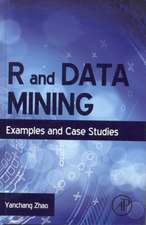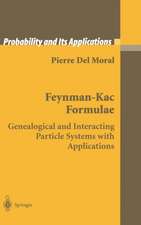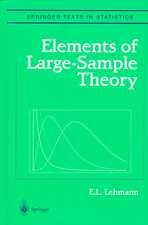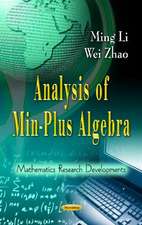Monte Carlo and Quasi-Monte Carlo Sampling: Springer Series in Statistics
Autor Christiane Lemieuxen Limba Engleză Hardback – 27 feb 2009
This book presents essential tools for using quasi–Monte Carlo sampling in practice. The first part of the book focuses on issues related to Monte Carlo methods—uniform and non-uniform random number generation, variance reduction techniques—but the material is presented to prepare the readers for the next step, which is to replace the random sampling inherent to Monte Carlo by quasi–random sampling. The second part of the book deals with this next step. Several aspects of quasi-Monte Carlo methods are covered, including constructions, randomizations, the use of ANOVA decompositions, and the concept of effective dimension. The third part of the book is devoted to applications in finance and more advanced statistical tools like Markov chain Monte Carlo and sequential Monte Carlo, with a discussion of their quasi–Monte Carlo counterpart.
The prerequisites for reading this book are a basic knowledge of statistics and enough mathematical maturity to follow through the various techniques used throughout the book. This text is aimed at graduate students in statistics, management science, operations research, engineering, and applied mathematics. It should also be useful to practitioners who want to learn more about Monte Carlo and quasi–Monte Carlo methods and researchers interested in an up-to-date guide to these methods.
| Toate formatele și edițiile | Preț | Express |
|---|---|---|
| Paperback (1) | 588.69 lei 6-8 săpt. | |
| Springer – 6 dec 2010 | 588.69 lei 6-8 săpt. | |
| Hardback (1) | 649.87 lei 6-8 săpt. | |
| Springer – 27 feb 2009 | 649.87 lei 6-8 săpt. |
Din seria Springer Series in Statistics
- 14%
 Preț: 679.60 lei
Preț: 679.60 lei - 20%
 Preț: 630.97 lei
Preț: 630.97 lei - 20%
 Preț: 816.43 lei
Preț: 816.43 lei - 20%
 Preț: 1000.84 lei
Preț: 1000.84 lei -
 Preț: 390.84 lei
Preț: 390.84 lei - 20%
 Preț: 697.13 lei
Preț: 697.13 lei - 20%
 Preț: 445.20 lei
Preț: 445.20 lei - 20%
 Preț: 881.51 lei
Preț: 881.51 lei - 18%
 Preț: 1237.14 lei
Preț: 1237.14 lei - 18%
 Preț: 967.22 lei
Preț: 967.22 lei - 18%
 Preț: 956.50 lei
Preț: 956.50 lei - 18%
 Preț: 794.25 lei
Preț: 794.25 lei - 15%
 Preț: 648.05 lei
Preț: 648.05 lei - 18%
 Preț: 1222.49 lei
Preț: 1222.49 lei - 15%
 Preț: 646.11 lei
Preț: 646.11 lei - 15%
 Preț: 647.08 lei
Preț: 647.08 lei - 15%
 Preț: 646.11 lei
Preț: 646.11 lei - 18%
 Preț: 1389.62 lei
Preț: 1389.62 lei - 15%
 Preț: 652.81 lei
Preț: 652.81 lei - 18%
 Preț: 1114.52 lei
Preț: 1114.52 lei - 18%
 Preț: 952.40 lei
Preț: 952.40 lei - 18%
 Preț: 1393.27 lei
Preț: 1393.27 lei - 18%
 Preț: 1561.68 lei
Preț: 1561.68 lei - 18%
 Preț: 1231.47 lei
Preț: 1231.47 lei - 15%
 Preț: 513.64 lei
Preț: 513.64 lei - 18%
 Preț: 893.71 lei
Preț: 893.71 lei - 15%
 Preț: 649.87 lei
Preț: 649.87 lei - 18%
 Preț: 1007.65 lei
Preț: 1007.65 lei - 18%
 Preț: 1111.67 lei
Preț: 1111.67 lei - 18%
 Preț: 1229.10 lei
Preț: 1229.10 lei - 18%
 Preț: 892.74 lei
Preț: 892.74 lei - 18%
 Preț: 913.26 lei
Preț: 913.26 lei - 18%
 Preț: 943.88 lei
Preț: 943.88 lei -
 Preț: 391.61 lei
Preț: 391.61 lei -
 Preț: 391.22 lei
Preț: 391.22 lei - 18%
 Preț: 1391.04 lei
Preț: 1391.04 lei -
 Preț: 390.84 lei
Preț: 390.84 lei - 18%
 Preț: 893.84 lei
Preț: 893.84 lei - 18%
 Preț: 960.61 lei
Preț: 960.61 lei - 18%
 Preț: 1245.34 lei
Preț: 1245.34 lei - 18%
 Preț: 964.54 lei
Preț: 964.54 lei - 15%
 Preț: 643.16 lei
Preț: 643.16 lei - 18%
 Preț: 1674.70 lei
Preț: 1674.70 lei - 15%
 Preț: 643.84 lei
Preț: 643.84 lei - 15%
 Preț: 586.37 lei
Preț: 586.37 lei - 18%
 Preț: 1004.99 lei
Preț: 1004.99 lei - 15%
 Preț: 643.34 lei
Preț: 643.34 lei - 18%
 Preț: 806.40 lei
Preț: 806.40 lei - 18%
 Preț: 727.66 lei
Preț: 727.66 lei
Preț: 649.87 lei
Preț vechi: 764.55 lei
-15% Nou
Puncte Express: 975
Preț estimativ în valută:
124.36€ • 130.43$ • 103.52£
124.36€ • 130.43$ • 103.52£
Carte tipărită la comandă
Livrare economică 01-15 aprilie
Preluare comenzi: 021 569.72.76
Specificații
ISBN-13: 9780387781648
ISBN-10: 0387781641
Pagini: 373
Ilustrații: XIV, 373 p.
Dimensiuni: 155 x 235 x 23 mm
Greutate: 0.68 kg
Ediția:2009
Editura: Springer
Colecția Springer
Seria Springer Series in Statistics
Locul publicării:New York, NY, United States
ISBN-10: 0387781641
Pagini: 373
Ilustrații: XIV, 373 p.
Dimensiuni: 155 x 235 x 23 mm
Greutate: 0.68 kg
Ediția:2009
Editura: Springer
Colecția Springer
Seria Springer Series in Statistics
Locul publicării:New York, NY, United States
Public țintă
Professional/practitionerCuprins
The Monte Carlo Method.- Sampling from Known Distributions.- Pseudorandom Number Generators.- Variance Reduction Techniques.- Quasi–Monte Carlo Constructions.- Using Quasi#x2013;Monte Carlo in Practice.- Financial Applications.- Beyond Numerical Integration.
Recenzii
From the reviews:
“This book is well structured as a complete guide to Monte Carlo and quasi Monte Carlo sampling methods. The author has done a nice job presenting the key concepts and explaining the theories of these valuable methods with examples and applications. Along with the problem sets provided at the end of each chapter, this book can serve well as a textbook for an advanced graduate course on Monte “Carlo and quasi Monte Carlo sampling methods or as a reference book for a course on computational statistics or numerical methods. This book is definitely an important contribution to the computational statistics and mathematics community.” (Technometrics)
“Monte Carlo and Quasi-Monte Carlo Sampling packs an enormous amount of material into a small space, while remaining very readable. The sections have a nice balance, with exposition, mathematical derivation, pseudocode, and numerical examples combining to introduce the reader to the intricacies of Monte Carlo methods. The book is strongest in its explanations of the basic Monte Carlo method and how quasi-Monte Carlo methods operate. That is, it is best at describing how to turn function evaluations into estimates, and how to decide where to take those function evaluations. … This is a book aimed for the Monte Carlo novice and would be suitable for a student with a semester of undergraduate probability or statistics. The pace is fast, with many subsections lasting only a page or two. Despite the concise delivery, I found the descriptions very readable, and Lemieux has a talent for closing quickly to the essence of an algorithm or idea. In addition, the topics are very well referenced. … In total, the result is a remarkably inclusive introduction to Monte Carlo and quasi-Monte Carlo methods. The coverage is not deep given the length devoted to most topics, but the wealth of references combined with a clear writing style make this a great text for a first course inMonte Carlo methods.” (Journal of the American Statistical Association, June 2010, Vol. 105, No. 490)
“This book is a nice survey of some Monte Carlo and quasi-Monte Carlo (or quasirandom) approaches to integration problems. … This book focuses on the use of the quasirandom approach and its relationship to Monte Carlo. … A strong point of this book is its modern treatment of the quasirandom approach and its application. … The writing is very clear and enjoyable to read. … an excellent source for a graduate student or researcher who wants to learn more about the quasi-Monte Carlo approach.” (Michael J. Evans, Mathematical Reviews, Issue 2012 b)
“This book is well structured as a complete guide to Monte Carlo and quasi Monte Carlo sampling methods. The author has done a nice job presenting the key concepts and explaining the theories of these valuable methods with examples and applications. Along with the problem sets provided at the end of each chapter, this book can serve well as a textbook for an advanced graduate course on Monte “Carlo and quasi Monte Carlo sampling methods or as a reference book for a course on computational statistics or numerical methods. This book is definitely an important contribution to the computational statistics and mathematics community.” (Technometrics)
“Monte Carlo and Quasi-Monte Carlo Sampling packs an enormous amount of material into a small space, while remaining very readable. The sections have a nice balance, with exposition, mathematical derivation, pseudocode, and numerical examples combining to introduce the reader to the intricacies of Monte Carlo methods. The book is strongest in its explanations of the basic Monte Carlo method and how quasi-Monte Carlo methods operate. That is, it is best at describing how to turn function evaluations into estimates, and how to decide where to take those function evaluations. … This is a book aimed for the Monte Carlo novice and would be suitable for a student with a semester of undergraduate probability or statistics. The pace is fast, with many subsections lasting only a page or two. Despite the concise delivery, I found the descriptions very readable, and Lemieux has a talent for closing quickly to the essence of an algorithm or idea. In addition, the topics are very well referenced. … In total, the result is a remarkably inclusive introduction to Monte Carlo and quasi-Monte Carlo methods. The coverage is not deep given the length devoted to most topics, but the wealth of references combined with a clear writing style make this a great text for a first course inMonte Carlo methods.” (Journal of the American Statistical Association, June 2010, Vol. 105, No. 490)
“This book is a nice survey of some Monte Carlo and quasi-Monte Carlo (or quasirandom) approaches to integration problems. … This book focuses on the use of the quasirandom approach and its relationship to Monte Carlo. … A strong point of this book is its modern treatment of the quasirandom approach and its application. … The writing is very clear and enjoyable to read. … an excellent source for a graduate student or researcher who wants to learn more about the quasi-Monte Carlo approach.” (Michael J. Evans, Mathematical Reviews, Issue 2012 b)
Notă biografică
Christiane Lemieux is an Associate Professor and the Associate Chair for Actuarial Science in the Department of Statistics and Actuarial Science at the University of Waterloo in Canada. She is an Associate of the Society of Actuaries and was the winner of a “Young Researcher Award in Information-Based Complexity” in 2004.
Textul de pe ultima copertă
Quasi–Monte Carlo methods have become an increasingly popular alternative to Monte Carlo methods over the last two decades. Their successful implementation on practical problems, especially in finance, has motivated the development of several new research areas within this field to which practitioners and researchers from various disciplines currently contribute.
This book presents essential tools for using quasi–Monte Carlo sampling in practice. The first part of the book focuses on issues related to Monte Carlo methods—uniform and non-uniform random number generation, variance reduction techniques—but the material is presented to prepare the readers for the next step, which is to replace the random sampling inherent to Monte Carlo by quasi–random sampling. The second part of the book deals with this next step. Several aspects of quasi-Monte Carlo methods are covered, including constructions, randomizations, the use of ANOVA decompositions, and the concept of effective dimension. The third part of the book is devoted to applications in finance and more advanced statistical tools like Markov chain Monte Carlo and sequential Monte Carlo, with a discussion of their quasi–Monte Carlo counterpart.
The prerequisites for reading this book are a basic knowledge of statistics and enough mathematical maturity to follow through the various techniques used throughout the book. This text is aimed at graduate students in statistics, management science, operations research, engineering, and applied mathematics. It should also be useful to practitioners who want to learn more about Monte Carlo and quasi–Monte Carlo methods and researchers interested in an up-to-date guide to these methods.
Christiane Lemieux is an Associate Professor and the Associate Chair for Actuarial Science in the Department of Statistics and Actuarial Science at the University of Waterloo in Canada. She is an Associate of the Society of Actuaries and was the winner of a"Young Researcher Award in Information-Based Complexity" in 2004.
This book presents essential tools for using quasi–Monte Carlo sampling in practice. The first part of the book focuses on issues related to Monte Carlo methods—uniform and non-uniform random number generation, variance reduction techniques—but the material is presented to prepare the readers for the next step, which is to replace the random sampling inherent to Monte Carlo by quasi–random sampling. The second part of the book deals with this next step. Several aspects of quasi-Monte Carlo methods are covered, including constructions, randomizations, the use of ANOVA decompositions, and the concept of effective dimension. The third part of the book is devoted to applications in finance and more advanced statistical tools like Markov chain Monte Carlo and sequential Monte Carlo, with a discussion of their quasi–Monte Carlo counterpart.
The prerequisites for reading this book are a basic knowledge of statistics and enough mathematical maturity to follow through the various techniques used throughout the book. This text is aimed at graduate students in statistics, management science, operations research, engineering, and applied mathematics. It should also be useful to practitioners who want to learn more about Monte Carlo and quasi–Monte Carlo methods and researchers interested in an up-to-date guide to these methods.
Christiane Lemieux is an Associate Professor and the Associate Chair for Actuarial Science in the Department of Statistics and Actuarial Science at the University of Waterloo in Canada. She is an Associate of the Society of Actuaries and was the winner of a"Young Researcher Award in Information-Based Complexity" in 2004.
Caracteristici
Many books have been written on the Monte Carlo method and its applications, especially in finance, stochastic simulation, and quasi-Monte Carlo methods Presents all these topics together in one place in a unified way, by continuously using the interplay between integration and simulation Reader will be able to apply random sampling to a wide range of problems and understand how to replace it by highly-uniform sampling Includes supplementary material: sn.pub/extras














